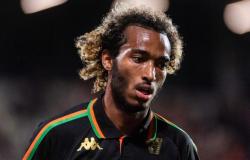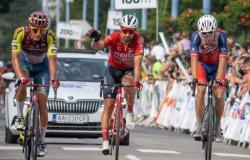It was created by the artist Giovanni Gasparro the Drappellone for the Palio di Siena on 2 July 2024, Palio di Provenzano; below is an illustration of the work by Axel Hemerydirector of the National Art Gallery of Siena.
Faced with the Palio, the artist, and to a greater extent his fearful and chatty companion, the art historian, have humility as their only choice – this is the beginning of Axel Hemery’s intervention illustrating the Drappellone del Palio of Siena on 2 July 2024 -. The client is not the Municipality, forgive me the Mayor, but the Palio itself, understood as a superior entity of a sacred order and as a community aggregated by the perennial present of a long history. Giovanni Gasparro was chosen for his fame, his style, his conception of art and his moral and philosophical attitude, but today he arrives naked and fasting before you, as if he had never painted a canvas in life of him. Like the craftsman of the Gothic cathedrals, he wants to offer a masterpiece to the clients, who are none other than the entire community, and he knows that he must forget about his own skill to get involved; and Gasparro certainly doesn’t lack skill.
Giovanni Gasparro found himself in the urgent need to absorb a world that was not his to take on the role of the creator of the Palio di Provenzano, traditionally attributed to Sienese artists. Siena cannot be improvised or tamed. The approach to Siena is progressive and requires a total absence of prejudices and absolute trust in the ferrymen you choose. I am personally doing this route every day and I can confirm that the journey is happily without return.
What are the characteristics of the artist that could facilitate this path of knowledge? First comes Faith understood in all its nuances: that of Gasparro, intense and pivotal to his existence, is perhaps not the widespread one in Siena, with pagan roots, forgive me His Eminence, that surrounds the Palio. Then comes the recognition of the past as a lifeblood, which would be the Sienese DNA, and Gasparro expresses himself with pictorial means that are largely those of the past. To these two main assumptions, Faith and the fervent relationship with the past, we can add the very Sienese awareness shared by Gasparro that little depends on us and that fate reigns as a mistress, the fatum, the same fatum that presides over the extraction of the Contrade, the assignment of the horse, the order of the move and the circumstances of the Carriera. Even the Drappellone in some way depicts the artist as Madame Bovary writes Flaubert. Just like Saint Luke, an artist inspired by an invisible creator, or the Evangelist Matthew in the predella by Martino di Bartolomeo at the Pinacoteca Nazionale in Siena (how could I not mention it?), who dips his pen of ink into the inkwell offered to him by his inspiring angel, Giovanni Gasparro also follows paths that have been assigned to him from above.
The icing on the cake or perhaps the stone of the cherry, Giovanni Gasparro grew up, lives and still works in Adelfia, in the province of Bari, where there is one of the most beautiful patronal festivals in Southern Italy, the feast of San Trifone. So he is well equipped to understand what it means to live the past in the present. Every year, since he became a boy capable of dreaming, the ritual was renewed and every day was a preparation for the party as every day of the Sienese calendar is. Without transplanting himself and experiencing the trauma of exile, our artist knows that tradition marks the heart and the bowels even more than the intellect.
Having drawn this portrait of the artist as a young man, and still a young man, there is no longer any doubt that he was ready to respond worthily to the prestigious commission.
His first test was the “Palio dei cittini”. Although he was an adept of chiaroscuro, he chose to paint a monochrome between beige and brown, where the jockey citizen dressed in black and white on his rocking horse stands out like an echo of the prance. The lightness of the subject was echoed by the lightness of the pictorial treatment. Gasparro was clearly paying homage to his beloved 1600s, not the Caravaggio style, but rather the Nordic one of trompe l’oeil with exposed frame nails. The artist passed the exam of managing the constraints of depicting all the Contrade by inserting their names on notes affixed either to a map of Tuscany or directly to the wall. In that way he managed to be faithful to tradition while being original.
However, the decisive test is that of the Drappellone di Provenzano that we have before our eyes, a test without appeal because from today the time for chatter and criticism opens, a time that can seem infinite until the final judge, Career and, after that, there it will always be at least one Contrada to say that that Cencio is the most beautiful of all time. But we want a rational judgement, even if we accept everything that is passionate about the Palio. And after having had the privilege of sharing Giovanni Gasparro’s research and being one of the first to see it, I can say that it is beautiful, without buts and without ifs, and that it will overcome the time of discussions to leave a trace even among those who don’t. ‘he will have torn, held, hugged and sprinkled with tears of joy.
Gasparro’s Drappellone is bold in its classicism. Perhaps it is an observation that could be made for all of the author’s pictorial production. But the way in which he renounces narration to delve into the paths of symbol is singular. And the primordial symbol for this great connoisseur of religion and mysticism is the immaculate white of purity and moral perfection. A white that combines the celestial and earthly registers. A white that through a game of mirrors is a repetition of the Drappellone. That is, the subject of the Drappellone is a Madonna of Provenzano holding a Drappellone. And, behind this attitude, there is the gift of the Palio to the Contrada and the city and the renewal of an atavistic relationship of veneration and affection. Behind the apparent simplicity of the image lies a vision of vertigo. And of this Cencio depicted, Gasparro makes us understand the solidity, the resistance to being folded and embraced, without ever tearing. The sheet is also a curtain that rises not only on a square and a Carriera, but above all on the “world city” of Siena. To contrast this expanse of white, a bit of black was needed and Balzana was not enough for this effect. The strongest scenographic idea to bring this black to the Palio and to the Piazza is the presence behind the scenes of the Palio holder. Raising the curtain symbolizes the part of shadow that surrounds every mystery, but at the same time it is as if it comments on the show in the manner of the choir of Greek tragedy or the reciter of Bach’s cantatas. A doubled presence on a real and symbolic level.
The artist escapes the practice of his predecessors of creating Drappelloni full of characters and horses, consequently full of movement and confusion and subjected to the horror of the void. I imagine the immaculate solemnity of the Cencio in the midst of the jubilation and the fray and I can already taste the contrast. A brilliant idea was to reduce the galloping of horses to a single horseshoe, the loss of which has marked many careers, therefore a symbolic element but absolutely concrete and material. This horseshoe is displayed by a putto as a trophy. The coats of arms of the Contrade that run are depicted as if they were embroidered with gold thread on the Drappellone, a tribute both to the skill of the seamstresses and to that golden thread that connects Siena to its past.
As always, some will want to read warning signs in this Drappellone – concludes Axel Emery in the illustration of Giovanni Gasparro’s work for the Palio di Siena on 2 July 2024 -. Their imagination really has no limits. We leave them on the threshold of this territory which is all theirs and which no longer belongs to us. The artist fulfilled his task. His world is study. The time has come to entrust to the tuff and the square, urbi et orbi, forgive me once again, Eminence, this Cencio which will belong to everyone and then to a part of the whole forever. And even if only one of the peoples that make up this grandiose city will preserve it as an ever-living relic, a timeless trophy, a pulse, a compass, the object made into a work will forever be part of this unique museum network in the world of these seventeen treasures , universal heritage of humanity, material and symbolic.
GO to the article on Giovanni Gasparro’s Drappellone for the Palio di Siena on 2 July 2024
The Masgalano for the 2024 Palii created by Lara Aldrovandi





